
Discovering what’s the best milk to put in your coffee is probably the hardest experiment that I’ve ever carried out. The main reason being: not all milks suit all tastes out there. Obviously, there are a lot of things to factor: do we prefer darker coffee or a lighter, milkier version? How strong of a coffee taste do we want? Would a foamy, creamy finish be best, like the cow milk version? See? There are many variables to take into account, so we tried our best to talk about them all in today’s post!
Before showing you everything I discovered, I’d like to talk you through a series of important tips to take into account when choosing a milk that’s best suited to our tastes.
BASIC CONCEPTS:
1- Dairy milk versus homemade plant milk
There’s one important concept not to forget whenever we compare plant milks to dairy, and that’s the fact that no combination (of all 30 I tried) is exactly the same than cow’s milk. Does that milk they’re worse? Not at all! Some of them we’ll like even better, some of them we will loathe, but there’s something fun about trying all versions, to see which flavours and textures we like best. For that reason, it’s best to start afresh, with no fake expectations!
2- Homemade plant milk versus storebought plant milk
 Results from using storebought milk versus homemade also vary. The results of this experiments all come from using homemade milks made with Vegan Milker. If there’s any of you who doesn’t already know the differences between homemade or package milk, you can check out the basic info on this article: Differences between “homemade” and “prepackaged” vegan milks.
Results from using storebought milk versus homemade also vary. The results of this experiments all come from using homemade milks made with Vegan Milker. If there’s any of you who doesn’t already know the differences between homemade or package milk, you can check out the basic info on this article: Differences between “homemade” and “prepackaged” vegan milks.
3- Coffee recipe
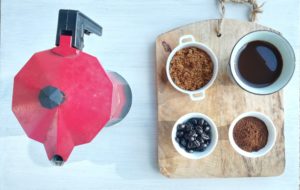 There are as many different tastes and preferences for coffee blends as colours in the world. In order to carry out the experiment, I’ve used an Italian coffee-maker made coffee, that is to say, a really strong, concentrated blend. This made it easier to identify the best milks to add to your coffee. In my case, I always go for fair-trade coffee, and I prefer an Arabica variety myself. In order to make the blends, I used the following proportions:
There are as many different tastes and preferences for coffee blends as colours in the world. In order to carry out the experiment, I’ve used an Italian coffee-maker made coffee, that is to say, a really strong, concentrated blend. This made it easier to identify the best milks to add to your coffee. In my case, I always go for fair-trade coffee, and I prefer an Arabica variety myself. In order to make the blends, I used the following proportions:
- “Cortado” coffee: ¾ cup coffee and ¼ cup plant milk
- Latte: ½ cup milk ½ cup plant milk
4- Plant milks + heat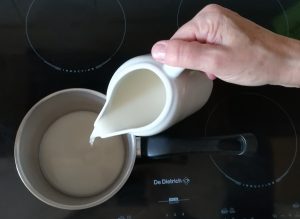
Plant milks tend to be super sensible to temperature changes. Most of them are ruined when heated to the point of boiling. In order to keep an optimum quality, it’s best to heat them on low heat, never going over 60ºC. You have much more useful info in our article “how to heat plant milks without losing nutrients”
5- Small practical dictionary
We’ll be using words that I made up myself in order to properly describe all new textures and flavours!

- Cloudy texture: physical effect, very visual. It happens when milk and coffee mix together. It will look as if it was curdled, but it’s not the case. This effect will disappear when stirring the mixture with a spoon and will appear afterwards sometimes. It doesn’t pose any health problem, as cloudy texture is merely a visual effect.
- Sedimentation: sedimentation is common when it comes to homemade plant milks. When chilling, milk particles sediment, creating a thicker layer at the bottom of the bottle or glass. It’s a physical effect only, and doesn’t have an impact on the milk taste or health properties, but it’s always nice to stir milk before consuming.
- Reverse sedimentation: sometimes, the milk layer is denser than coffee, so it’s at the top of the cup. Again, it doesn’t pose any health problem at all, but it’s always nice to stir the milk before consuming.
- Homogeneous milk: stable coffee-milk mixture without cloudy texture or sedimentation.
- Foam: small bubbly layer at the top of the milk, adding a creamy feel.
Now that the basic concepts are clear, let’s get to it! It’s been so fun to experiment with all the delicious milk.
As you see, I’ve been playing with many different options to suit all preferences and also sort out any doubt you may have. This way, you’ll be able to experiment too, to create your own favourite version.
What’s the best plant milk for coffee?
As mentioned earlier, plant milks are often different, both flavor and texture-wise, to cow’s milk. That’s the reason why, when they’re subjected to temperature changes, the results are so surprising. Here are the results I got when I tried all the possible combinations:
1- Cortado with intense coffee flavour
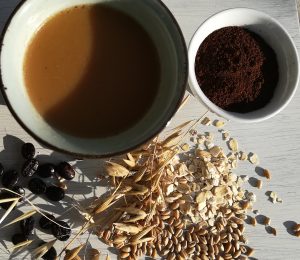 If we’re into black coffee, and wouldn’t want a lighter, weaker version but we still wish to add some plant milk so we get some extra nutrients, I’d suggest milk made from grains, such as rice or oat milk , also from soy. The remaining mixture is homogeneous, with barely any sedimentation.
If we’re into black coffee, and wouldn’t want a lighter, weaker version but we still wish to add some plant milk so we get some extra nutrients, I’d suggest milk made from grains, such as rice or oat milk , also from soy. The remaining mixture is homogeneous, with barely any sedimentation.
2-Milkier cortado coffee
If we’d like to actually taste the milk in the coffee, we ought to prepare a weaker, less concentrated coffee. We should be using around 10mg of coffee per cup, as of we were making tea.
In this case, the tastier milks would be milks made from nuts, such as delicious almond, hazelnut or walnut versions.
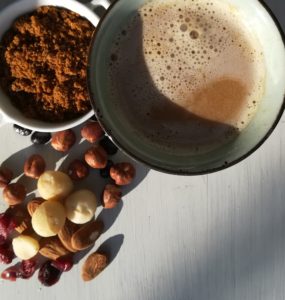 All of them are less creamy than the traditional cow’s milk, but this problem can be solved adding 4 macadamia nuts (that’s 20g) per litre. This way, we’ll get a creamier milk, and it’ll have a foamy layer on top, which goes super well with coffee.
All of them are less creamy than the traditional cow’s milk, but this problem can be solved adding 4 macadamia nuts (that’s 20g) per litre. This way, we’ll get a creamier milk, and it’ll have a foamy layer on top, which goes super well with coffee.
When it comes to nuts, we can also double the amount of nuts used (about 150-200g) to make a creamier milk. However, in my experience, it’s not worth the extra money, since the results from using a standard 1:10 ratio of nuts to milk, aren’t that different.
Nut milk, such as almond or hazelnut are delicious, but they can result in cloudy texture or reverse sedimentation when subjected to thermal changes.
Almond milk, for example, produces a cream which is hard to homogenize. This doesn’t happen, however, with walnuts or hazelnuts.
As you know, these cream layers are in no way bad for your health, although you may think that the milk will have curdled and therefore it’s not safe to consume. Again: this is not the case, and anyway, it can be solved by stirring with a spoon.
3- Plant milk latte
When using a 1:1 ratio of coffee and milk, the possibilities are endless. We can use any plant milk we fancy. Here are our favourite choices, depending on the kind of coffee we’re after:
 3.1. Creamy, dense coffee: rice or oat milk will add that thick creamy feel we’re looking for. They also add quality carbs, natural fibre and vitamins which aid in nervous system health. They work super well when making hot chocolate too, thanks to the higher amount of fibre.
3.1. Creamy, dense coffee: rice or oat milk will add that thick creamy feel we’re looking for. They also add quality carbs, natural fibre and vitamins which aid in nervous system health. They work super well when making hot chocolate too, thanks to the higher amount of fibre.
3.2. Tasty, aromatic coffee: if you care more about flavour rather than texture, nut milks are for you! Almond, coconut, cashew milks are options for you to try!
4- Macchiato style coffee
If you like a bigger milk to coffee ratio, the options suggested in point three will work for you. Tigernut milk will also work in blends with less coffee, so that’s something to take into account!
5- Plant milk with soluble coffee
 Any kind of milk works well with a spoonful of instant coffee granules!
Any kind of milk works well with a spoonful of instant coffee granules!
To sum up, here are the main characteristics of every plant milk family:
- Rice, oat or other grain milks make for a thicker, creamier coffee and a neutral flavour.
- Nut milks are delicious, but they shouldn’t be heated over 60ºC since they are prone to sedimentation.
- Soy milk is not particularly great when it comes to taste or flavour, but it stands well against heat and produces stable, homogeneous blends.
- Tigernut milk: a delicious milk, for sure, but this one is really sensitive to heat and other factors. One should be careful when heating homemade tigernut milk so it doesn’t stick to the bottom of the pan.
- Sunflower, hemp and small seeds milk: they add a really original touch to coffee, but they tend to layer and create a foamy texture.
FINAL CONCLUSION and Tips & Tricks
 If we think that plant milk isn’t strong enough to change the flavour of coffee, we can play with the different ratios, playing with the amount of coffee and milk used in order to obtain results we like, both colour and flavour-wise.
If we think that plant milk isn’t strong enough to change the flavour of coffee, we can play with the different ratios, playing with the amount of coffee and milk used in order to obtain results we like, both colour and flavour-wise.- If we want to make a more concentrated milk, we should be careful when it comes to doubling the amount of some ingredients. Note that this tip only works with soy and nuts, since grains tend to behave differently. For example, those ingredients rich in starch will make the milk super thick when used in the wrong proportions, so when you’re starting out, it’s best to follow a proven recipe!
We really hope that this post is useful for you! Let us know if you have any more tips or stuff you’d like us to try! We’ll keep experimenting!
More coffee recipes:
- Caffè Latte.
- The best vegan Cappuccino.

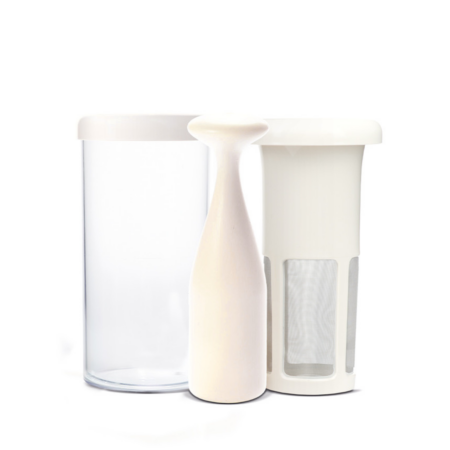


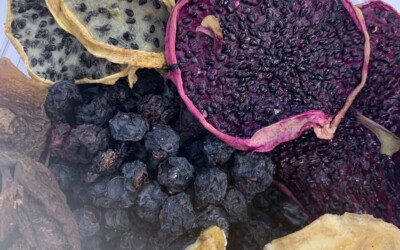
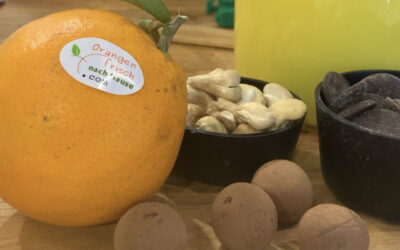
I want to find the perfect creamy fat free plant coffee cream.
No nuts.
No oil.
No soy.
No other taste. Just the taste of a really flavourful coffee bean but with the experience of double dairy cream in it.
The closest I have come is Experience made with oats and chia seeds. I’d love to know how to make it myself.
Hi Lynda, make homemade oat milk it’s really easy. Here is the recipe https://www.plantmilk.org/homemade-oat-milk-best-recipes-and-tricks/ , but making milk with chia is difficult. Chia seed milk is too sticky becouse the natural fiber and doesn’t filter well. I propose to make oat milk and after filtering add some chia seeds if you want. Cheers!
Good luck with that.